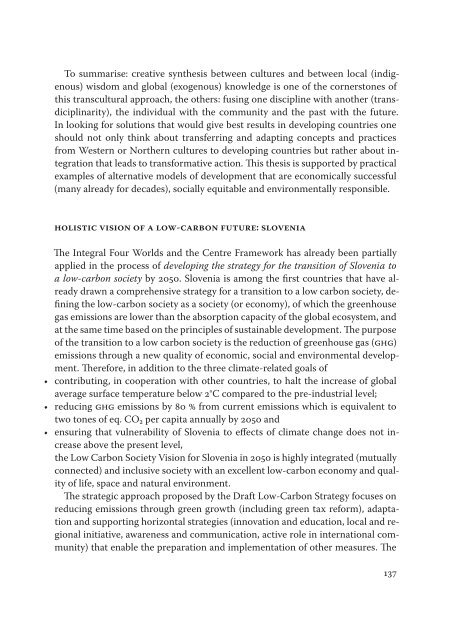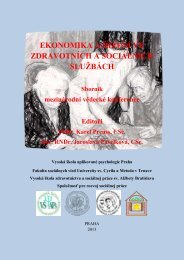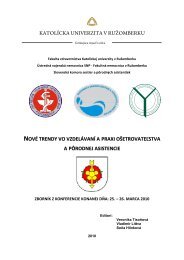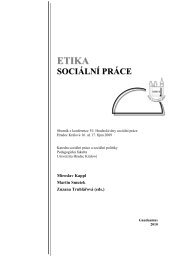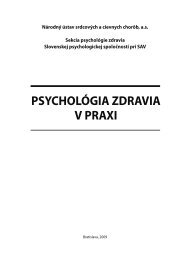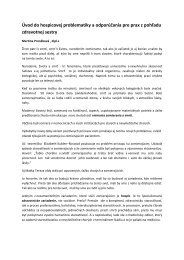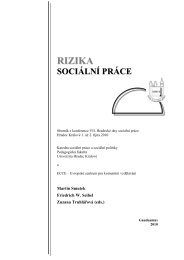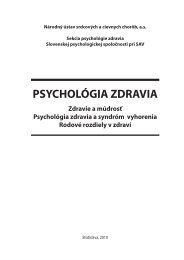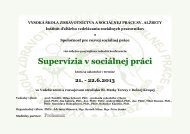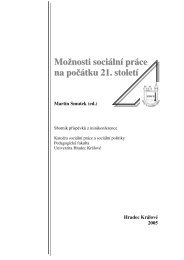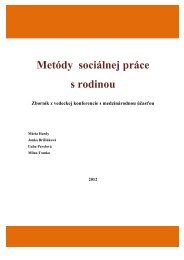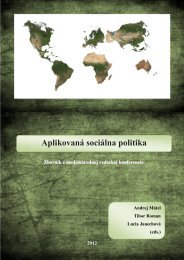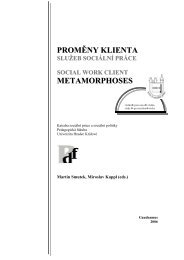Zmena klÃmy â možný dopad (nielen) na obyvateľstvo - Prohuman
Zmena klÃmy â možný dopad (nielen) na obyvateľstvo - Prohuman
Zmena klÃmy â možný dopad (nielen) na obyvateľstvo - Prohuman
Create successful ePaper yourself
Turn your PDF publications into a flip-book with our unique Google optimized e-Paper software.
To summarise: creative synthesis between cultures and between local (indigenous)<br />
wisdom and global (exogenous) knowledge is one of the cornerstones of<br />
this transcultural approach, the others: fusing one discipline with another (transdicipli<strong>na</strong>rity),<br />
the individual with the community and the past with the future.<br />
In looking for solutions that would give best results in developing countries one<br />
should not only think about transferring and adapting concepts and practices<br />
from Western or Northern cultures to developing countries but rather about integration<br />
that leads to transformative action. This thesis is supported by practical<br />
examples of alter<strong>na</strong>tive models of development that are economically successful<br />
(many already for decades), socially equitable and environmentally responsible.<br />
Holistic Vision of a Low-Carbon Future: Slovenia<br />
The Integral Four Worlds and the Centre Framework has already been partially<br />
applied in the process of developing the strategy for the transition of Slovenia to<br />
a low-carbon society by 2050. Slovenia is among the first countries that have already<br />
drawn a comprehensive strategy for a transition to a low carbon society, defining<br />
the low-carbon society as a society (or economy), of which the greenhouse<br />
gas emissions are lower than the absorption capacity of the global ecosystem, and<br />
at the same time based on the principles of sustai<strong>na</strong>ble development. The purpose<br />
of the transition to a low carbon society is the reduction of greenhouse gas (GHG)<br />
emissions through a new quality of economic, social and environmental development.<br />
Therefore, in addition to the three climate-related goals of<br />
• contributing, in cooperation with other countries, to halt the increase of global<br />
average surface temperature below 2°C compared to the pre-industrial level;<br />
• reducing GHG emissions by 80 % from current emissions which is equivalent to<br />
two tones of eq. CO2 per capita annually by 2050 and<br />
• ensuring that vulnerability of Slovenia to effects of climate change does not increase<br />
above the present level,<br />
the Low Carbon Society Vision for Slovenia in 2050 is highly integrated (mutually<br />
connected) and inclusive society with an excellent low-carbon economy and quality<br />
of life, space and <strong>na</strong>tural environment.<br />
The strategic approach proposed by the Draft Low-Carbon Strategy focuses on<br />
reducing emissions through green growth (including green tax reform), adaptation<br />
and supporting horizontal strategies (innovation and education, local and regio<strong>na</strong>l<br />
initiative, awareness and communication, active role in inter<strong>na</strong>tio<strong>na</strong>l community)<br />
that e<strong>na</strong>ble the preparation and implementation of other measures. The<br />
137


